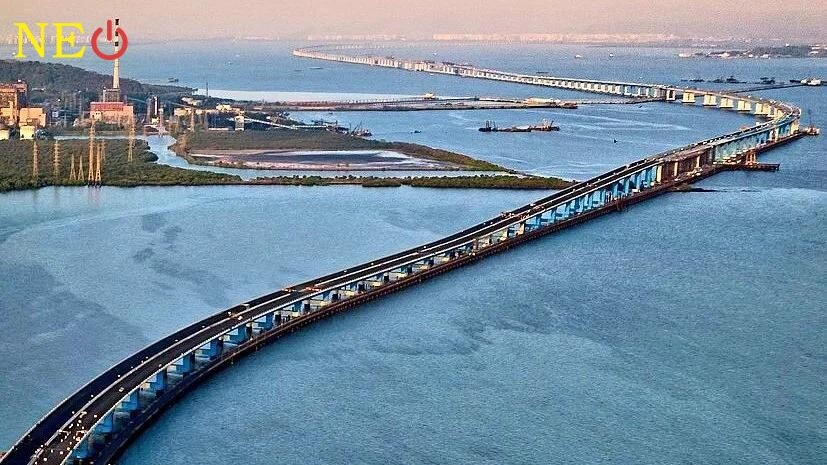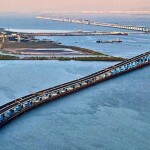Atal Setu, one of the nation's longest bridges, stands as a marvel in engineering and construction. Its steel utilization dwarfs even the iconic Eiffel Tower, with 17 times the steel employed in its construction. Compared to the Howrah Bridge, this architectural feat boasts four times the amount of structural steel. Furthermore, the significant sea link required six times the concrete used for the Statue of Liberty. In terms of scale and importance, Atal Setu emerges as a testament to modern engineering prowess.
In a monumental feat of engineering and connectivity, Prime Minister Narendra Modi is set to inaugurate the nation's longest bridge in Mumbai on Friday. This extraordinary structure stands out not only for its sheer length but also for the impressive statistic that it incorporates a staggering 17 times more steel than the iconic Paris Eiffel Tower. Beyond its steel magnificence, the bridge holds the promise of transforming the lives of the local inhabitants by significantly reducing travel time between Mumbai and Navi Mumbai.
Currently, the journey between these two bustling metropolises takes around 20 minutes, creating a daily challenge for commuters. However, with the unveiling of this groundbreaking bridge, a new era of connectivity and convenience is on the horizon. The bridge not only ranks among the nation's longest but also claims the title of being the longest sea bridge in India.
As the Prime Minister opens the gateway to smoother and swifter travel, the significance of this infrastructure marvel cannot be overstated. It symbolizes progress, efficiency, and a commitment to enhancing the lives of the people it serves. The 17 times more steel than the Paris Eiffel Tower isn't just a statistic; it's a testament to the scale and ambition of this engineering marvel, reflecting the nation's prowess in executing projects of grandeur.
Beyond the reduction in travel time, the bridge is poised to become an iconic symbol of unity, linking two vibrant hubs of activity. It's not merely a structure of steel and concrete; it's a lifeline that binds communities, fosters economic growth, and showcases India's capability to undertake and execute infrastructure projects of global significance.
As the nation eagerly anticipates the inauguration of this exceptional bridge, it marks not just a physical connection but a bridge to progress, convenience, and a brighter future for the people of Mumbai and Navi Mumbai. Prime Minister Modi's role in bringing forth this transformative project underscores a commitment to infrastructure development that goes beyond mere transportation – it's a gateway to a more connected, efficient, and accessible India.
More concrete than the Statue of Liberty
Commissioner Mukherjee of the Mumbai Metropolitan Region Development Authority revealed to ANI on Thursday the astounding engineering feat achieved in the construction of a bridge that now stands as a testament to innovation and scale. This architectural marvel has surpassed even the iconic Eiffel Tower, utilizing a staggering 17 times more steel. In comparison to the historic Howrah Bridge, known for its grandeur, this new structure boasts four times the amount of structural steel, showcasing a leap in engineering prowess.
Not only is this bridge a symbol of strength, but it also surpasses global landmarks in its use of materials. The amount of structural steel employed dwarfs that used in the construction of the Statue of Liberty by an astonishing 17 times. Commissioner Mukherjee underlined the monumental effort that went into the construction, emphasizing the commitment to pushing the boundaries of architectural achievement.
Beyond its sheer scale, Mukherjee highlighted the incorporation of cutting-edge technology and modern amenities. The use of orthotropic steel decking, a technology allowing for the delivery of extremely large spans, sets this bridge apart as a marvel of contemporary engineering. It not only stands tall but also spans great lengths, both literally and metaphorically.
In a nod to environmental responsibility, the bridge incorporates features to safeguard marine life. River circulation rings have been strategically employed to mitigate noise and vibration, demonstrating a commitment to harmonizing infrastructure development with ecological sustainability. This reflects a conscientious approach in the face of progress, ensuring that advancements are not at the expense of the natural world.
Commissioner Mukherjee's remarks underscore not just the physical enormity of this bridge but its significance in pushing the boundaries of architectural and engineering excellence. As it stands, this bridge is not merely a structure; it is a symbol of innovation, sustainability, and a testament to human capability. The blending of modern technology with an awareness of environmental impact positions this infrastructure project as a model for future endeavors, setting a standard for responsible development in an ever-evolving world.
The pool will not harm the aquatic environment or natural things.
He added that the aquatic ecosystem surrounding the bridge won't be disturbed or disrupted by the lighting employed in it. The environmental sustainability of this bridge is also one of its most significant qualities. This historical landmark has also received a certificate of appreciation from the environmental group Bombay Natural History Society.
The Commissioner claimed that this bridge is equipped with the most cutting-edge traffic control technology. Among other things, it may identify fog, poor vision, and cars that are going faster than the posted speed limit. The biggest "Atal Bridge" in the nation is constructed on land, in the swamp, and in the sea. Experts in their fields from ten different nations have contributed to this project, which has a budget of Rs. twenty-one thousand crore. To finish this project, about 1500 engineers and about 16500 experienced workers put in around 16 hours a day, working in three shifts.









